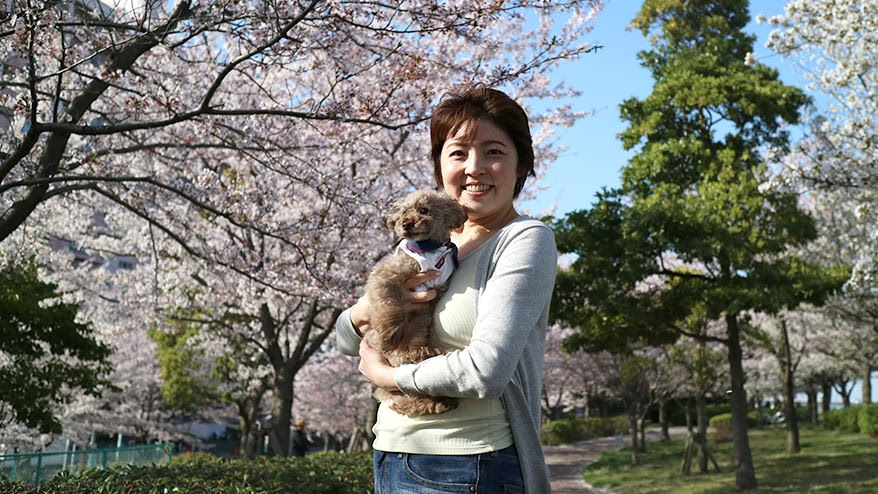こんにちは、セールス部の奥山です。
私は大の犬好きで、今年7歳になるトイプードルのくるみと暮らしています。日々忙しく生活する中で、犬との暮らしは癒しだけでなく毎日元気に働くための活力になっています。また、くるみを迎えたことで、家族との会話が増えて一緒に出掛けることも多くなりました。
毎朝のおはようの挨拶から元気いっぱいで人懐っこい性格のくるみからパワーをもらえている感じがします。
今回は犬と暮らしはじめたきっかけと私なりの犬のしつけについてお伝えしようと思います。

くるみ
犬と生きる喜びは子どもの頃から
私は犬とともに育ったと言えるほど、小さいころから犬と一緒に生活してきました。雑種や秋田犬など自分より大きな大型犬を番犬として飼っていて、時には犬小屋の中で一緒にいることもあったそうです。友だちと遊ぶように犬と接していたのかもしれません。 くるみを飼う前は実家でラブラドール・レトリバーと暮らしていましたし、実家を離れてからも、いつかまた犬を飼いたいとずっと思っていました。我が家は主人(おっくー)と二人暮らしですが、おっくーは犬を飼ったことがありませんでした。また猫アレルギーのあるおっくーのためになるべく抜け毛の少ない犬を飼おうと話し合いました。
犬種選びについてふたりの意見をまとめました
まずは、自分たちの暮らしに最適な犬を飼うために、二人で譲れない条件をピックアップしてみました。
- マンションでも飼える小型犬であること
- 抜け毛が少なく、においが少ない
- お散歩は少なくて大丈夫
- 一緒に旅行に行きたい
- メス犬であること
そうして飼ってみたいと思った犬種がトイプードルでした。そこから私たちのブリーダーさん探しが始まります。ペットショップではなく、ブリーダーさんから子犬を迎え入れるメリットはたくさんあります。なかでも一番大切なことはコミュニケーションが育まれること。子犬はブリーダーさんの元で産まれてから2ヵ月間、親兄弟と一緒に暮らし、遊びなどを通してコミュニケーションの取り方を自然と学んでいくのです。
それからは、トイプードル・ブリーダーズというポータルサイトをチェックする日々。また、トイプードルを飼う人のブログも毎日のように読んでいました。
たくさんのプードルを見ていると、自分たちの好みも見えてきます。トイプードルはいろいろなカラーがありますが、中でも希少と言われているブラウンは大人びていて落ち着きがあると言われているため、私たちには最適なのでは、という結論になりました。
そんななか、ある時ブラウンのブリーディングをしている、この方こそ!と思えるブリーダーさんを見つけることができました。そして、犬を飼いたいと思い探し始めてから2年ほど経ったころ、ついにブラウンのプードルの出産情報が掲載されました!
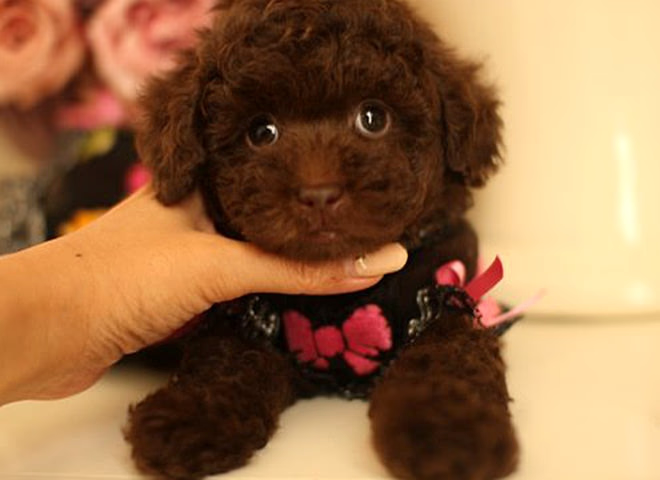

その時の掲載写真です 茶色のもふもふちゃん。まだスマホサイズです
くるみとの出会い
早速ブリーダーさんに見学希望の問合せをして、会いに行きました。
ブリーダーさんの犬舎はプードルの関節に優しい犬専用のタイル張り、全室床暖房を完備と至れり尽くせりなとても素敵なお宅でした。もちろん、母犬にも会うことができました。ブラウンはいずれ退色することが多いカラーで、この時、母犬の色を見て成犬になったときの素敵なカラーもイメージすることができました。くるみの名前は私がつけたのですが、その時の母犬のグレージュカラ―からつけた名前です。
くるみは父犬、母犬ともにブラウンのトイよりやや小さめなタイニーサイズから生まれました。同じく女の子の姉妹が一緒のサークルに入っていて、どちらも本当にかわいい子犬でした。迷っていると、ブリーダーさんがくるみのことを「性格はおっとりしていて、聞き分けのよい子です。無駄吠えなどなく、しつけやすいですよ」と紹介してくださいました。おっしゃる通り、のんびりマイペースに私の膝の上で寝てしまったくるみ。「この子にしよう」とその時決めました。
その時点でくるみは生後2ヵ月でしたが、きちんと準備を整えて半月後に再度子犬を迎えにいくことにしました。それからは家に屋根付きのケージ、トイレトレー、ベット、キャリーバック、おもちゃやぬいぐるみ、スリッカーやコームなどのケア製品などを購入しました。犬が滑りやすいフローリングをカーペット敷きにして、我が家は犬仕様に様変わりしました。
いよいよお迎えの日。空のキャリーバックを持って、ブリーダーさん宅に行くと、既にお姉さん犬は飼い主が決まっていなくなり、くるみはひとりで遊んでいました。再度ブリーダーさんから当面の注意事項や質問確認などをさせていただき、その後もしばらくはわからないことをメールでやり取りさせていただきました。くるみは初めての電車でもおとなしく、家に着いたらすぐにペットシーツにおしっこをするなど、本当に良い子でした。
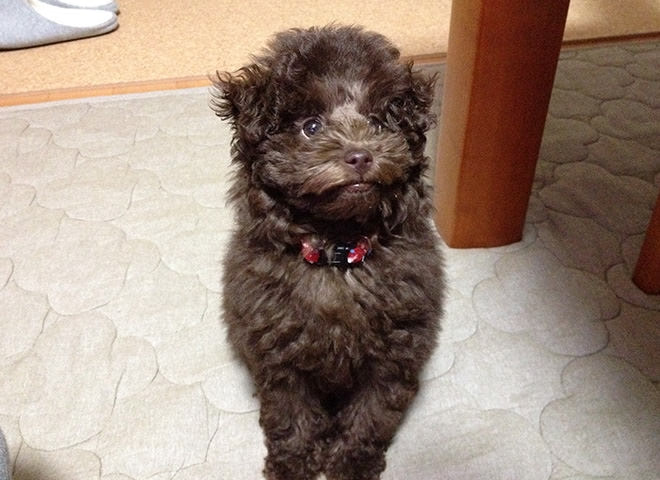
我が家にきてから20日後のくるみ。トリミング前なのでモサモサです
子犬を迎えたときの注意点と私たちのしつけについて
あらゆる犬の飼い方本などにも書いてありますが、新しい家に到着した当日は子犬を静かに見守り、新しい環境や、音、匂い、そして人に慣れてもらうことが大切です。私たちも可愛い子犬と遊びたいのを我慢して、まずはゆっくり慣れてもらうためにゲージに入れて見守りました。そして、この日から我が家の一員として一緒に末長く暮らすためのしつけもはじまりました。今回は、私たちがくるみをしつける上で特に気をつけていて、そしてとてもよかったと思っているしつけの五カ条もお伝えしたいと思います。
くるみのしつけ5ヵ条
1. トイレトレーニング
ブリーダーさんからくるみを受け取った時点でほぼ8割程度はマスターしていましたが、犬を飼う上でトイレトレーニングはとても重要です。成功したら褒める、失敗しても叱らないをモットーに焦らずにトレーニングしました。排泄のタイミングで一緒に「チー、チー」と掛け声をかけます。ちゃんとトイレでおしっこができたら、オーバーなくらいに褒めておやつをあげます。これを繰り返し毎回行なうことで、100%マスターすることができました。もちろん失敗することもありますが、その時は黙って消臭スプレーで掃除をして終わりです。家族で褒め方やマテ、フセ、スワレなどの飼い主の指示(コマンド)は統一させることも重要です。
2. クレートトレーニング
クレートとは、犬を入れて運ぶプラスチックのケースです。仙台に住んでいる友人に災害時のことを考えてクレートトレーニングをしておくことは重要と教えてもらいました。早速クレートトレーニングについて調べて実行。犬は元々狭い穴倉で暮らしていた動物なので、狭くて暗い所を好む傾向があるそうです。安心してリラックスできる場所だと覚えさせるために、おもちゃを入れたり、おやつを入れてクレートにまず入ってもらうことから始めました。同時に「ハウス」と声を掛けることを繰り返し続けていきます。「ハウス」の掛け声で自分からハウスに入ったら褒めておやつをあげると、扉を閉めてもずっとクレートに入っていられるようになりました。
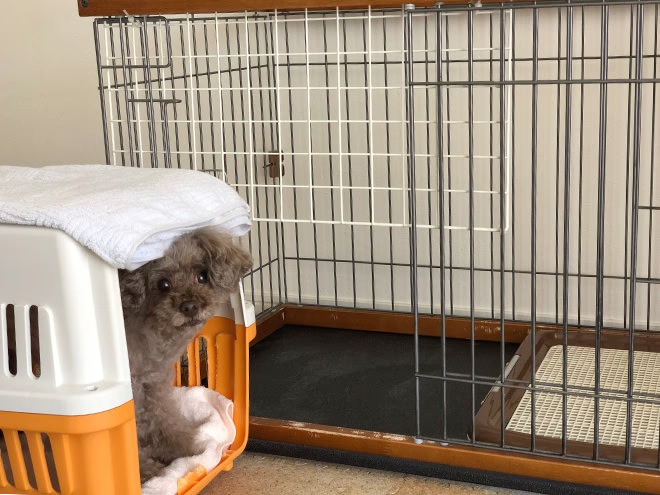
お留守番のときはケージの入り口とクレートをくっつけてしまいます
3.お留守番トレーニング
うちは共働きで平日は最低10時間くらいお留守番することが必要になります。子犬の間はトイレをする間隔も短いため、ケージとクレートを繋げた庭付きの戸建て風にしました。クレートは寝る場所、起きたらトイレにも行けるようにしています。お留守番をさせるときに重要なことは、「いってきます」とか「ただいま」を言わないこと。「いい子に留守番しててね」なんて絶対言いません。かえって不安にさせてしまうからです。帰ってきてもすぐに犬に駆け寄りたいのを我慢して、自分が着替えたり片づけをして犬が落ち着いていい子にしていたらリビングに出して褒めてあげます。お留守番が当たり前と思ってもらうために、初日から1時間ほどお留守番をしてもらいました。今では私が会社に行くときは「ハウス」と言わなくても黙ってクレートに入りおやつを待っています。
4.ごはん・歯磨きトレーニング
今まで犬を飼ったときにはご飯や散歩を規則的な決まった時間にしていました。そうすると、犬はその時間になるとご飯を要求するようになります。そこで、今回くるみにはあえてご飯の時間をランダムにしています。そして飼い主と犬との食事の順番は、主従関係に影響するため私たちの食事が先に、犬は後にすることが大切です。常に飼い主のペースに犬をあわせることが重要です。
小さいころから歯磨きは努力してみましたが、嫌がることと、なかなかうまくいかないため諦めていました。ガーゼで磨く程度で無麻酔の犬の歯医者さんに通ってクリーニングをお願いしていました。ところが、数年前に歯周病になってしまい、病院を変えて治療をしました。歯周病は命に関わる病気なので、それからは毎食時に歯磨きをしています。まずは1本磨けたら褒めてご飯の1粒をあげることを繰り返しました。そして半年に1度は歯医者さんに通って検診や歯科クリーニングも受けています。
5.社会化トレーニング
子犬は生後~4カ月頃までを「社会化期」 と言い、社会性を身に付ける社会化に適した時期だそうです。ですがワクチンを済ませるまでは散歩には行けません。そのため抱っこして外の音や匂いに触れさせていました。くるみは元々無駄吠えがない犬ですが、他の犬や人とふれ合うことを小さいころから行っています。人が大好きでフレンドリーな性格も社会化トレーニングのおかげかもしれません。
トリミングサロンのペットホテルにトレーニングのために預けたり、知り合いのトレーナーさん宅に預かってもらったりもしました。
今振り返ると、小さいころはかなり厳しくしつけをしていたように思います。ブラウントイプードルの性格の影響もあるかもしれませんが、小さなころ、くるみは自立していて、あまり私たちに甘えない犬でした。3歳のころから少しずつ甘えてくれるようになり、膝の上に乗って寝るようになったのもこのころからでした。犬を飼うことはとても大変ですが、毎日が癒されるだけでなく、家族の会話が増えて楽しく生活ができています。仕事を頑張ろうと思えるのも、きっとくるみのおかげかもしれません。
また、くるみとの日々をご紹介できたらと思います。
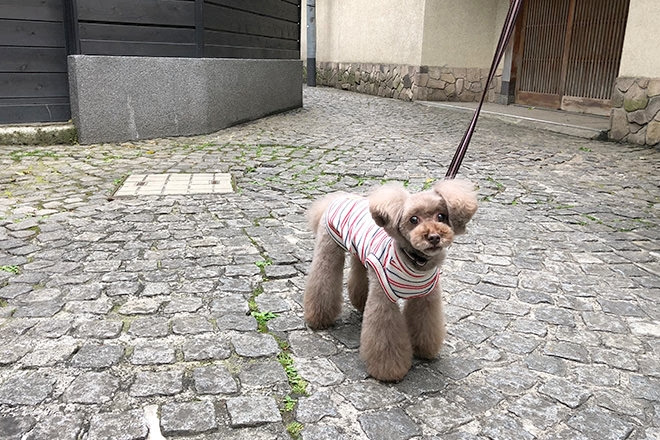
月1回のトリミングを終えて、お散歩中
